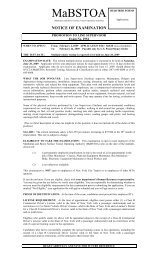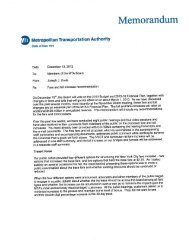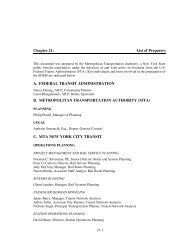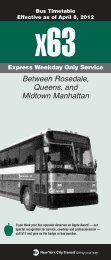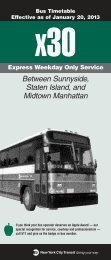Greening Mass Transit & Metro Regions: The Final Report - MTA
Greening Mass Transit & Metro Regions: The Final Report - MTA
Greening Mass Transit & Metro Regions: The Final Report - MTA
You also want an ePaper? Increase the reach of your titles
YUMPU automatically turns print PDFs into web optimized ePapers that Google loves.
10<br />
Top Recommendations for <strong>Greening</strong> the <strong>MTA</strong> and the <strong>MTA</strong> Region<br />
<strong>The</strong> 22 commissioners divided into Working Groups focusing on key areas of sustainability. Each group consulted <strong>MTA</strong> staff and pro bono<br />
experts, commissioned research studies, and produced long-term transformational recommendations and near-term recommendations.<br />
<strong>The</strong> complete set of recommendations are found in each chapter.<br />
Energy/Carbon Working Group Facilities Working Group Smart Growth/TOD Working Group<br />
■ <strong>The</strong> <strong>MTA</strong> should draw 80 percent<br />
of its energy from renewable sources<br />
by 2050. To help achieve this, the<br />
<strong>MTA</strong> should join a consortium of<br />
public entities to pursue offshore<br />
wind farms capable of generating up<br />
to 1,500 megawatts of clean energy.<br />
■ <strong>The</strong> <strong>MTA</strong> should identify carbon<br />
avoidance as a revenue source to<br />
underscore the <strong>MTA</strong>’s role as a provider<br />
of climate stabilization services in its<br />
region and to establish the value of<br />
<strong>MTA</strong> services under any decarbonization<br />
policy (carbon tax, cap-and-trade,<br />
post-Kyoto /Copenhagen rules, etc.).<br />
■ <strong>The</strong> <strong>MTA</strong> should reduce operational<br />
energy use and GHG emissions on a<br />
per-passenger mile basis by 25 percent<br />
by 2019 through energy retrofits, smart<br />
fleet technologies, and more.<br />
■ <strong>The</strong> <strong>MTA</strong> should establish a “green”<br />
<strong>Metro</strong>Card contribution program,<br />
through which customers could make<br />
voluntary, tax-deductible donations to<br />
fund green aspects of sustainable capital<br />
and operating projects at the <strong>MTA</strong>.<br />
■ <strong>The</strong> <strong>MTA</strong> should field test and<br />
implement weight reduction and<br />
regenerative braking technologies, as<br />
recommended by the Commission’s<br />
Smart Fleets Task Force.<br />
<strong>The</strong> Need for Sustainable Capital Spending at the <strong>MTA</strong><br />
■ <strong>The</strong> <strong>MTA</strong> should adopt Leadership<br />
in Energy and Environment Design<br />
(LEED) Silver as its standard for all<br />
building projects, new construction, and<br />
major renovations wherever applicable,<br />
and either recommission existing<br />
buildings or pursue LEED Existing<br />
Buildings: Operations and Maintenance<br />
(LEED-EB) where possible.<br />
■ For all other transit facilities not<br />
covered by LEED Silver standards,<br />
the <strong>MTA</strong> should develop <strong>MTA</strong> Green<br />
Design Guidelines based on the<br />
LEED system.<br />
■ <strong>The</strong> <strong>MTA</strong> should develop a green<br />
Lifecycle Analysis (LCA) system for<br />
facilities to track the upfront costs and<br />
long-term savings from high-performance<br />
and regenerative design features.<br />
■ <strong>The</strong> <strong>MTA</strong> should increase the number<br />
of LEED-accredited employees and<br />
require 90 percent of new hires for<br />
facilities design positions to be LEED-<br />
Accredited Professionals (AP).<br />
■ <strong>The</strong> <strong>MTA</strong> should seek a LEED-EB<br />
rating for Grand Central Terminal.<br />
On December 4, 2008, the Commission on <strong>Metro</strong>politan Transportation Authority<br />
Financing, appointed by Governor David Paterson and chaired by Richard Ravitch,<br />
concluded that the <strong>MTA</strong>'s 2010-2014 capital program would require around $30 billion.<br />
That Ravitch Commission finding was consistent with the <strong>MTA</strong>’s own forecasts of its capital<br />
needs for the 2010-2014 program, which will enable the <strong>MTA</strong> to keep its core infrastruc-<br />
■ <strong>The</strong> <strong>MTA</strong> should capture two-thirds<br />
of all new vehicle miles traveled (VMT)<br />
generated within its region through 2030.<br />
To achieve this, the <strong>MTA</strong> should advise<br />
communities and collaborate with them<br />
on how to create and expand feeder and<br />
distributor lines and eliminate gaps in<br />
the regional transit network.<br />
■ <strong>The</strong> <strong>MTA</strong> should promote clustered<br />
development throughout its region,<br />
seeking to draw two-thirds of all new<br />
development to within a quarter-mile<br />
to a half-mile of transit access within<br />
the <strong>MTA</strong> network.<br />
■ <strong>The</strong> <strong>MTA</strong> should take the lead in<br />
closing the “last mile” transportation<br />
gap by improving access to transit<br />
through robust, flexible feeder and<br />
distributor services, as well as pedestrian<br />
and bike improvements.<br />
■ <strong>The</strong> <strong>MTA</strong> should develop a systemwide<br />
TOD program that articulates<br />
principles and guidelines for TOD<br />
project development and should assist<br />
communities, developers, and stakeholders<br />
throughout the region in planning<br />
these community-based initiatives.<br />
ture in a state of good repair, continue work on its mega-projects and adjust the capital<br />
program to take account of inflation.<br />
<strong>The</strong> Blue Ribbon Commission on Sustainability and the <strong>MTA</strong> believes that the vitality of<br />
the region and its economy cannot be maintained without a robust, resilient <strong>MTA</strong> infrastructure.<br />
<strong>The</strong> Sustainability Commission has considered the impact of critical sustainability





